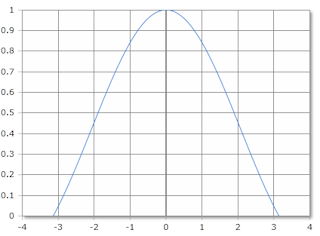Sinc - Calculate Cardinal Sine
Online calculator for calculating the unnormalized cardinal sine
Cardinal Sine Calculator
Instructions
Enter the angle whose cardinal sine you want to calculate, select the unit of measure (degrees or radians) and click Calculate.
Cardinal Sine - Overview
Value Range
The angle is given in degrees (-180° to +180°) or radians (-π to +π).
Result: The cardinal sine returns values in the range approximately -0.217 to 1, with maximum value 1 at x = 0.

Cardinal sine, scale in radians
Unnormalized Definition
The cardinal sine (sinus cardinalis) is defined as the sine of x divided by x. This calculator uses the unnormalized form:
\(\displaystyle \text{sinc}(x) = \begin{cases} \frac{\sin(x)}{x} & \text{for } x \neq 0 \\ 1 & \text{for } x = 0 \end{cases} \)
Normalized Form
In signal processing, the normalized form is often used:
\(\displaystyle \text{sinc}_{\text{norm}}(x) = \frac{\sin(\pi x)}{\pi x} \)
|
|
Description of the Cardinal Sine
Fundamentals
The cardinal sine (Latin: sinus cardinalis) is an analytical function that plays an important role in signal processing, Fourier analysis, and mathematics. It is defined as the sine of x divided by x.
Unnormalized Definition:
\(\displaystyle \text{sinc}(x) = \frac{\sin(x)}{x} \quad \text{for } x \neq 0 \)
\(\displaystyle \text{sinc}(0) = 1 \)
(determined by the limit as x approaches 0)
Properties
The cardinal sine function has several important properties:
- Continuous: The function is continuous everywhere, including at x = 0
- Even function: sinc(-x) = sinc(x)
- Maximum: sinc(0) = 1
- Zeros: At x = ±π, ±2π, ±3π, ... (non-zero multiples of π)
- Oscillating: Decays with increasing |x|
Two Definitions
The notation is not uniform:
Unnormalized (used here):
\(\displaystyle \text{sinc}(x) = \frac{\sin(x)}{x} \)
Normalized (signal processing):
\(\displaystyle \text{sinc}(x) = \frac{\sin(\pi x)}{\pi x} \)
Detailed Examples
Example 1: Calculate at x = 0
Task:
Calculate sinc(0)
Solution:
Although sin(0)/0 is undefined, the limit is:
\(\displaystyle \lim_{x \to 0} \frac{\sin(x)}{x} = 1 \)
Therefore: sinc(0) = 1
Example 2: Calculate at x = π
Task:
Calculate sinc(π)
Calculation:
\(\displaystyle \text{sinc}(\pi) = \frac{\sin(\pi)}{\pi} = \frac{0}{\pi} = 0 \)
Result: sinc(π) = 0 (first zero crossing)
Example 3: Important Values
Key cardinal sine values:
- sinc(0) = 1 (maximum)
- sinc(π/2) ≈ 0.637
- sinc(π) = 0 (first zero)
- sinc(3π/2) ≈ -0.212 (first minimum)
- sinc(2π) = 0 (second zero)
- sinc(±nπ) = 0 for all integers n ≠ 0
Limit Proof
The limit can be proven using L'Hôpital's rule:
\(\displaystyle \lim_{x \to 0} \frac{\sin(x)}{x} = \lim_{x \to 0} \frac{\cos(x)}{1} = 1 \)
Mathematical Properties
- Symmetry: Even function: sinc(-x) = sinc(x)
- Zeros: At x = ±nπ for all integers n ≠ 0
- Maximum: Global maximum of 1 at x = 0
- Local extrema: At approximately x = ±1.43π, ±2.46π, ...
- Decay: Amplitude decreases as 1/x for large |x|
- Fourier transform: The sinc function is its own Fourier transform (with appropriate normalization)
- Integration: \( \int_{-\infty}^{\infty} \text{sinc}(x) \, dx = \pi \)
Practical Applications
- Signal processing: Ideal low-pass filter impulse response
- Sampling theory: Whittaker-Shannon interpolation formula
- Optics: Fraunhofer diffraction pattern
- Image processing: Lanczos resampling
- Radio engineering: Pulse shaping
- Telecommunications: Bandwidth-limited signals
- Physics: Quantum mechanics and wave packets
- Mathematics: Fourier analysis and transform theory
Normalized vs Unnormalized
Unnormalized (Mathematics):
\(\displaystyle \text{sinc}(x) = \frac{\sin(x)}{x} \)
Zeros: At x = ±π, ±2π, ±3π, ...
Normalized (Engineering):
\(\displaystyle \text{sinc}(x) = \frac{\sin(\pi x)}{\pi x} \)
Zeros: At x = ±1, ±2, ±3, ... (integers)
Important Note
The cardinal sine function has two common definitions that differ by a factor of π. This calculator uses the unnormalized form sinc(x) = sin(x)/x, which is common in mathematics. In digital signal processing and information theory, the normalized form sinc(x) = sin(πx)/(πx) is more common, as it simplifies many formulas. The normalized version has zeros at integer values (±1, ±2, ...), while the unnormalized version has zeros at multiples of π. Always check which definition is being used in your context! The function is continuous at x = 0 with the value sinc(0) = 1, determined by taking the limit using L'Hôpital's rule.
|
|